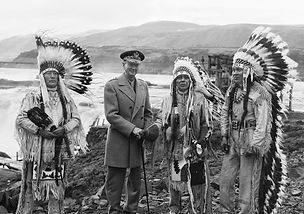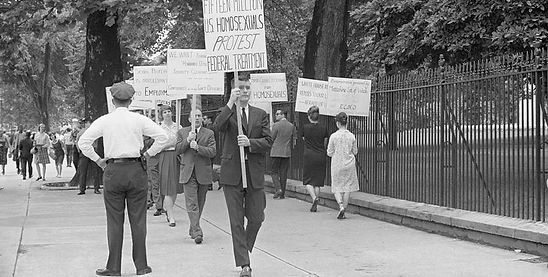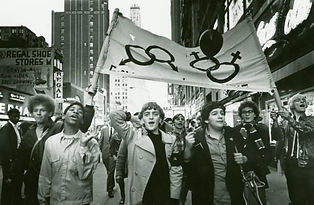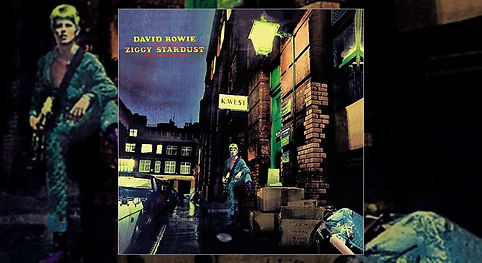
1950s
Native Movement
In the 1950s, Native Americans struggled with the government's policy of moving them off reservations and into cities where they might assimilate into mainstream America. Not only did they face the loss of land; many of the uprooted Indians often had difficulties adjusting to urban life.
Termination Act(s)
-
Policy of FORCED ASSIMILATION
-
This spawns the Pan-Tribal Activist Community
Additional Links

1951
The Homophile Movement and Mattachine Society
By the end of WWII, lesbians and gay men began to understand themselves as a social minority, oppressed and made invisible by the larger, unfeeling and heterosexual majority.
This kind of resistant thinking gave rise to what is known as the homophile movement. The primary goal of the homophile organization was to gain acceptance of gay and lesbians by heterosexuals.
By 1951 the Mattachine Society began sponsoring discussion groups that provided gay men, and lesbians with a safe space to share their experiences with being queer. This was often a cathartic experience for those that attended and thus snowballed to a more queer conscious mindset in groups that evidently was the reason for the organization to branch out into other cities including Chicago, New York, San Francisco, and Washington D.C.

1952
Creation of DSM
The first DSM, created in 1952, established a hierarchy of sexual deviancies, vaulting heterosexual behavior to an idealized place in American culture.


1954
Beginning of Civil Rights Movement
“ONLY THREE WEEKS TILL THE SUMMER OF “POWER TO THE PEOPLE!” I CAN’T WAIT. YOU’RE GONNA PROTEST WITH ME RIGHT?”- STARLA
The civil rights movement was a struggle for social justice that took place mainly during the 1950s and 1960s for Black Americans to gain equal rights under the law in the United States. The Civil War had officially abolished slavery, but it didn’t end discrimination against Black people—they continued to endure the devastating effects of racism, especially in the South.
Source: https://www.history.com/topics/black-history/civil-rights-movement

1959
First Gay Uprising
Predating the Stonewall Riots by ten years; Cooper Do-nuts in Los Angeles, CA was the site of a 1959 protest against the LAPD's harassment of the gay and transgender clientele frequenting the shop.
Due to Cooper Do-nuts' proximity to several gay and lesbian establishments– a case of resisting arrest evolved into a full-scale riot that s remembered as ;the first open act of LGBTQ resistance toward police abuse in the United States.

1969
Nixon Elected President
Richard M. Nixon was elected the 37th President of the United States (1969-1974).
NASA
On July 20, 1969, American astronauts Neil Armstrong (1930-2012) and Edwin "Buzz" Aldrin (1930-) became the first humans ever to land on the moon.

What Was Stonewall Inn?
The Stonewall uprising, also sometimes referred to as the Stonewall riots, began in the early morning hours of June 28, 1969 at the Stonewall Inn, a gay bar in New York City. As was typical during that time, police officers entered the bar and arrested employees for selling alcohol without a liquor license, roughed up many customers, cleared the bar and arrested several customers for not wearing at least three articles of “gender-appropriate” clothing (which was a New York criminal law at that time).
When raids like these happened in the past, customers would typically leave the premises. However, the LGBTQ community’s anger this time was strong and resolute as they watched customers being taken away in a police van. They began to taunt the police, throwing bottles and debris and as a result, the police officers called in reinforcements. What happened next was a spontaneous, violent demonstration that spawned additional demonstrations over several days by the LGBTQ community—both customers and neighbors.
Stonewall Riots
The uprisings ignited a new atmosphere of militant gay liberation. A new generation of activist organizations emerged, including the Gay Liberation Front and the Gay Activist Alliance. Like the homophile movement, these new organizations sought to end discrimination against gays and lesbians. Unlike the homophile organizations, however, these advocates for “gay liberation” embraced much more aggressive tactics throughout the 1970s.

AIM Occupied Alcatraz
From November 1969 to June 1971, AIM members occupied Alcatraz Island off San Francisco, saying they had the right to it under a treaty provision granting them unused federal land.
1970s
By the 1970s
By the summer of 1970, groups in at least eight American cities were sufficiently organized to schedule simultaneous events commemorating the Stonewall riots for the last Sunday in June. The events varied from a highly political march of three to five thousand in New York and thousands more at parades in Los Angeles, San Francisco and Chicago. While groups using the Gay Liberation Front name appeared around the U.S., in New York that organization was replaced totally by the Gay Activist Alliance.
Source: https://www.sutori.com/en/story/gay-liberation-movement--mvkScX3rej31PbyNxAgcCQrz
1972
First San Francisco Pride
The very first parade was held a year after the Stonewall Riots (1970) on Folsom Street, organized by the rock group Black Sabbath as a promotional event for a number of emerging bands.
That parade followed two years later (1972), with a huge attendance and a lot of very brave people. Notice the turnout was sparse (only two blocks of well-wishers turned out to watch the beginning of the parade, but the atmosphere was electric.
David Bowie’s 5th Studio Album
The Rise and Fall of Ziggy Stardust and the Spiders from Mars (often shortened to Ziggy Stardust) is the fifth studio album by English musician David Bowie, released on 16 June 1972
Bowie recorded his own album about a fictional character named Ziggy Stardust, who was inspired by both Iggy Pop and Lou Reed. While Bowie's influence on punk is undeniable, he never came nearly as close to actually writing punk music as he probably could have, but Ziggy Stardust, with its clear Lou Reed/The Velvet Underground and Iggy Pop/The Stooges influence, was the closest he did come. I think he was probably too naturally ambitious to ever make a record as simple and stripped-down as true punk, but Ziggy Stardust did a great job of marrying that ambition to music that had more than a little in common with The Stooges and The Velvet Underground. (Punk was also of course not fully a thing yet in 1972.

Additional Links
1973
DSM/Shock Theraphy
“YOUR DOC CALLED ME TODAY. SHE SAID ONE MORE ROUND OF SESSIONS! THEN YOU'RE FIXED FOR GOOD!” - MR. COLLINS
"IT’S AVERSION THERAPY. THEY SHOCK ME WHILE THEY SHOW ME...BAD PICTURES." - JONATHAN
“In 1973, the American Psychiatric Association (APA) removed the diagnosis of “homosexuality” from the second edition of its Diagnostic and Statistical Manual (DSM)”
Source: PODCAST - This American Life - DSM
"Declassification, as the years-long effort was known, culminated in 1973, when in May, LGBTQ+ voices were heard."
Wounded Knee Occupation
"IT WAS A RADICAL PROTEST AGAINST THE MISTREATMENT OF THE LAKOTA PEOPLE."
- STARLA
“I CAN’T BELIEVE YOU KNOW ALL THAT. SEEMS LIKE PEOPLE NEVER PAY ATTENTION TO THE SHIT THAT HAPPENS TO US.” - WEB
NASA
Skylab Launches May 14, 1973
“In 1973, the uncrewed Skylab was launched aboard a modified Saturn V launch vehicle from NASA’s Kennedy Space Center. The initial concept for the United States’ first space station was devised at NASA's Marshall Space Flight Center.”

Nixon
"IT’S PERFECT. YOU’RE FINALLY GOING TO GET TO YELL ABOUT NIXON IN PUBLIC LIKE YOU’VE ALWAYS WANTED." - JONATHAN
1973 - Nixon ended American involvement in Vietnam combat in 1973 and the military draft with it that same year.
“Richard Nixon was elected the 37th President of the United States (1969-1974) after previously serving as a U.S. Representative and a U.S. Senator from California. After successfully ending American fighting in Vietnam and improving international relations with the U.S.S.R. and China, he became the only President to ever resign the office, as a result of the Watergate scandal.” -
Source:

Women's Movement
1973 - Roe v. Wade, legal case in which the U.S. Supreme Court on January 22, 1973, ruled (7–2) that unduly restrictive state regulation of abortion is unconstitutional.
Source: Roe v. Wade legalized 1st trimester abortion in all fifty states.....
“Women's rights movement, also called women's liberation movement, diverse social movement, largely based in the United States, that in the 1960s and '70s sought equal rights and opportunities and greater personal freedom for women. It coincided with and is recognized as part of the “second wave” of feminism.”
-Elinor Burkett
Source: Womens-movement
1978
AIM
1978- American Indians were legally allowed to practice religion and language.
“The American Indian Movement (AIM) is a grassroots movement for Indigenous rights, founded in 1968 in Minneapolis, Minnesota. Originally an urban-focused movement formed in response to police brutality and racial profiling, AIM grew rapidly in the 1970s and became the driving force behind the Indigenous civil rights movement.”
Source: american-indian-movement-aim

1987
Homosexuality No Longer Considered A Mental Disorder
By 1987 the American Psychiatric Association removes homosexuality as a mental disorder completely.
Although in this new edition of the diagnostic and statistic manual, there is a new disorder labeled as “gender identity disorder” which arrives as a new label for transgender individuals.
Source: LGBTQ+ History Timeline

1990
Homosexuality No Longer Considered A Disease
By 1990 the World Health Organization officially removes Homosexuality as a disease.
Source: LGBTQ+ History Timeline

Linking Activity
-
Create practice of classroom land acknowledgment. (If this is already a practice have students unpack and go deeper with their current land acknowledgement.)
-
Research Land Back movement, practices and local programs. EXAMPLE: LANDBACK
"Jam out to Jonathan and Web's Spotify Playlist"
